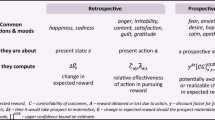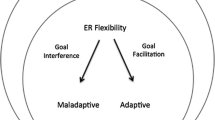Abstract
Spurred by a range of potential applications, there has been a growing body of research in computational models of human emotion. To advance the development of these models, it is critical that we evaluate them against the phenomena they purport to model. In this paper, we present one method to evaluate an emotion model that compares the behavior of the model against human behavior using a standard clinical instrument for assessing human emotion and coping. We use this method to evaluate the Emotion and Adaptation (EMA) model of emotion Gratch and Marsella. The evaluation highlights strengths of the approach and identifies where the model needs further development.
Similar content being viewed by others
References
J. Gratch and S. Marsella, “Tears and fears: Modeling emotions and emotional behaviors in synthetic agents”, presented at Fifth International Conference on Autonomous Agents, Montreal, Canada, 2001.
S. Marsella and J. Gratch, “The Modeling coping behaviors in virtual humans: Don’t worry, be happy”, presented at Second International Joint Conference on Autonomous Agents and Multi-agent Systems, Melbourne, Australia, 2003.
J. Gratch S. Marsella (2004) ArticleTitle“A domain independent framework for modeling emotion” J. Cognitive Sys. Res 5 269–306 Occurrence Handle10.1016/j.cogsys.2004.02.002
C. Conati (2002) ArticleTitle“Probabilistic assessment of user’s emotions in educational games” J. Appl. Artif. Intelligence, special issue on “Merging Cognition and Affect in HCI” 16 555–575
C. Conati and H. MacLaren, “Evaluating a probabilistic model of student affect,” presented at Seventh International Conference on Intelligent Tutoring Systems, Maceio, Brazil, 2004.
S. Marsella, W. L. Johnson, and C. LaBore, “Interactive pedagogical drama,” presented at Fourth International Conference on Autonomous Agents, Montreal, Canada, 2000.
B. O. Rothbaum L. F. Hodges R. Alarcon D. Ready F. Shahar K. Graap J. Pair P. Hebert B. Wills D. Baltzell (1999) ArticleTitle“Virtual environment exposure therapy for PTSD vietnam veterans: A case study” J. Trauma Stress 12 263–272 Occurrence Handle10.1023/A:1024772308758 Occurrence Handle1:STN:280:DyaK1MzgsF2hug%3D%3D Occurrence Handle10378165
J. C. Lester B. A. Stone G. D. Stelling (1999) ArticleTitle“Lifelike pedagogical agents for mixed-initiative problem solving in constructivist learning environments” User Model User-Adapted Instruction. 9 1–44 Occurrence Handle10.1023/A:1008374607830
K. Ryokai C. Vaucelle J. Cassell (2003) ArticleTitle“Virtual Peers as Partners in Storytelling and Literacy Learning” Journal of Computer Assisted Learning 19 IssueID2 195–208 Occurrence Handle10.1046/j.0266-4909.2003.00020.x
E. Shaw W. L. Johnson R. Ganeshan (1999) “Pedagogical agents on the web”, presented at Proceedings of the Third International Conference on Autonomous Agents Seattle WA
E. André T. Rist S. V. Mulken M. Klesen (2000) “The automated design of believable dialogues for animated presentation teams” J. Cassell J. Sullivan S. Prevost E. Churchill (Eds) Embodied Conversational Agents MIT Press Cambridge, MA 220–255
J. Cassell T. Bickmore L. Campbell H. Vilhjálmsson H. Yan (2000) “Human conversation as a system framework: Designing embodied conversational agents” J. Cassell J. Sullivan S. Prevost E. Churchill (Eds) Embodied Conversational Agents MIT Press Boston 29–63
B. G. Silverman, M. Johns, K. O’Brien, R. Weaver, and J. Cornwell, “Constructing Virtual Asymmetric Opponents from Data and Models in the Literature: Case of Crowd Rioting,” 11th Conference on Computer-Generated Forces and Behavior Representation, Orlanda FL, pp. 97–105, 2002.
J. Gratch S. Marsella (2003) ArticleTitle“Fight the way you train: The role and limits of emotions in training for combat” Brown J. World Affairs 10 IssueID1 63–76
S. Marsella, D. Pynadath, and S. Read, “PsychSim: Agent-based modeling of social interactions and influence,” presented at International Conference on Cognitive Modeling, 2004.
M. Minsky (1986) The Society of Mind Simon and Schuster New York
H. A. Simon (1967) ArticleTitle“Motivational and emotional controls of cognition” Psychological Rev 74 29–39 Occurrence Handle1:STN:280:CCiB38%2FpvFQ%3D
A. R. Damasio (1994) Descartes’ Error: Emotion, Reason, and the Human Brain Avon Books New York
K. Oatley P. N. Johnson-Laird (1987) ArticleTitle“Towards a Cognitive Theory of Emotions” Cognition and Emotion 1 IssueID1 29–50
A. Sloman M. Croucher (1981) “Why robots will have emotions”, presented at International Joint Conference on Artificial Intelligence Canada Vancouver
C. Lisetti P. Gmytrasiewicz (2002) ArticleTitle“Can a rational agent afford to be affectless? A formal approach” Appl. Artif. Intelligence 16 577–609 Occurrence Handle10.1080/08839510290030408
R. Frank (1988) Passions with Reason: The Strategic Role of the Emotions W. W. Norton New York, NY
A. R. Mele (2001) Self-Deception Unmasked Princeton University Press Princeton, NJ
W. Mao and J. Gratch, “Social judgment in multiagent interactions”, presented at Third International Joint Conference on Autonomous Agents and Multiagent Systems, 2004.
J. Gratch, J. Rickel, E. André, J. Cassell, E. Petajan, and N. Badler, “Creating interactive virtual humans: Some assembly required”, in IEEE Intelligent Syst., vol. July/August, pp. 54–61, 2002.
J. Rickel, S. Marsella, J. Gratch, R. Hill, D. Traum, and W. Swartout, “Toward a new generation of virtual humans for interactive experiences”, in IEEE Intelligent Syst., vol. July/August, pp. 32–38 2002.
S. Marsella, W. L. Johnson, and C. LaBore, “Interactive pedagogical drama for health interventions”, presented at Conference on Artificial Intelligence in Education, Sydney, Australia, 2003.
M. Cavazza, F. Charles, and S. J. Mead, “Agents’ interaction in virtual storytelling”, presented at Third International Workshop on Intelligent Virtual Agents, 2001.
C. L. Lisetti D. Schiano (2000) ArticleTitle“Facial expression recognition: Where human-computer interaction, artificial intelligence, and cognitive science intersect” Pragma Cognition 8 185–235
R. W. Picard (1997) Affective Computing MIT Press Cambridge, MA
S. van Mulken, E. André, and J. Muller, “The persona effect: how substantial is it,” presented at Human Computer Interaction Conference, Berlin, 1998.
W. Swartout, R. Hill, J. Gratch, W. L. Johnson, C. Kyriakakis, C. LaBore, R. Lindheim, S. Marsella, D. Miraglia, B. Moore, J. Morie, J. Rickel, M. Thiebaux, L. Tuch, R. Whitney, and J. Douglas, “Toward the holodeck: Integrating graphics, sound, character and story,” presented at Fifth International Conference on Autonomous Agents, Montreal, Canada, 2001.
R. Lazarus (1991) Emotion and Adaptation Oxford University Press NY
J. Velásquez, “When robots weep: Emotional memories and decision-making.,” presented at 15th National Conference on Artificial Intelligence, Madison, WI, 1998.
C. A. Smith R. Lazarus (1990) “Emotion and Adaptation” L. A. Pervin (Eds) Handbook of Personality: Theory and research Guilford Press NY 609–637
E. Peacock P. Wong (1990) ArticleTitle“The stress appraisal measure (SAM): A multidimensional approach to cognitive appraisal” Stress Medic 6 227–236
J. Blythe (1999) ArticleTitle“Decision Theoretic Planning” in AI Magazine 20 IssueID2 37–54
B. Grosz S. Kraus (1996) ArticleTitle“Collaborative plans for complex group action” Artif. Intelligence 86 IssueID2 269–357 Occurrence Handle10.1016/0004-3702(95)00103-4
K. G. Shaver (1985) The Attribution of Blame: Causality, Responsibility, and Blameworthiness Springer-Verlag NY
A. Ortony G. Clore A. Collins (1988) The Cognitive Structure of Emotions Cambridge University Press Cambridge
J. Gratch S. Marsella (2005) ArticleTitle“Lessons from Emotion Psychology for the Design of Lifelike Characters” Applied Artif Intelligence 19 IssueID3–4 215–233
C. Pelachaud, V. Carofiglio, B. D. Carolis, F. d. Rosis, and I. Poggi, “First international joint conference on autonomous agents and multiagent systems”, presented at Embodied Contextual Agent in Information Delivering Application, Bologna, Italy, 2002.
M. Klesen (2005) ArticleTitle“Using theatrical concepts for role-plays with educational agents” Appl. Artif. Intelligence Special Issue “Educational Agents - Beyond Virtual Tutors” 19 IssueID3–4 413–431
H. Nakanishi S. Shimizu K. Isbister (2005) ArticleTitle“Sensitizing social agents for virtual training” Appl. Artif. Intelligence Special Issue “Educational Agents - Beyond Virtual Tutors” 19 IssueID3–4 393–412
A. Cowell and K. M. Stanney, “Embodiement and interaction guidelines for designing credible, trustworthy embodied conversational agents”, presented at Intelligent Virtual Agents, Kloster Irsee, Germany, 2003.
J. C. Lester S. G. Towns C. B. Callaway J. L. Voerman P. J. FitzGerald (2000) “Deictic and emotive communication in animated pedagogical agents” J. Cassell S. Prevost J. Sullivan E. Churchill (Eds) Embodied Conversational Agents MIT Press Cambridge 123–154
G. Biswas, D. Schwartz, K. Leelawong, N. Vye, and TAG-V, “Learning by teaching. A new agent paradigm for educational software,” Appl. Artif. Intelligence special Issue “Educ. Agents - Beyond Virtual Tutors”, vol. 19, 2005.
C. Elliott, “The affective reasoner: A process model of emotions in a multi-agent system,” Ph.D Dissertation, Northwestern University Institute for the Learning Sciences, Northwestern, IL, vol. 32, 1992.
M. S. ElNasr J. Yen T. Ioerger (2000) ArticleTitle“FLAME: Fuzzy Logic Adaptive Model of Emotions” Autonomous Agents and Multi-Agent Systems 3 219–257 Occurrence Handle10.1023/A:1010030809960
D. Moffat and N. Frijda, “Where there’s a Will there’s an agent,” presented at Workshop on Agent Theories, Architectures and Languages, 1995.
J. L. Armony D. Servan-Schreiber J. D. Cohen J. E. LeDoux (1997) ArticleTitle“Computational modeling of emotion: Explorations through the anatomy and physiology of fear conditioning” Trends in Cognitive Sci 1 28–34 Occurrence Handle10.1016/S1364-6613(97)01007-3
D. Cañamero, “Modeling motivations and emotions as a basis for intelligent behavior”, presented at International Conference on Autonomous Agents, Marina del Rey, CA, 1997.
R. C. Arkin (2005) “Moving up the food chain: Motivation and Emotion in behavior-based robots” J. Fellous M. Arbib (Eds) Who Needs Emotions: The Brain Meets the Robot Oxford University Press New York
J. R. Busemeyer J. T. Townsend J. C. Stout (2002) “Motivational underpinnings of utility in decision making: Decision field theory analysis of deprivation and satiation” S. Moore (Eds) Emotional Cognition John Benjamins Amsterdam
P. Gmytrasiewicz and C. Lisetti, “Using decision theory to formalize emotions for multi-agent systems,” presented at Second ICMAS-2000 Workshop on Game Theoretic and Decision Theoretic Agents, Boston, 2000.
H. Prendinger, S. Mayer, J. Mori, and M. Ishizuka, “Persona effect revisited,” presented at Intelligent Virtual Agents, Kloster Irsee, Germany, 2003.
N. C. Kramer, B. Tietz, and G. Bente, “Effects of embodied interface agents and their gestural activity,” presented at Intelligent Virtual Agents, Kloster Irsee, Germany, 2003.
M. Scheutz and A. Sloman, “Affect and agent control: experiments with simple affective states,” presented at IAT, 2001.
M. Perrez M. Reicherts (1992) Stress, Coping, and Health Hogrefe and Huber Publishers Seattle, WA
Author information
Authors and Affiliations
Corresponding author
Rights and permissions
About this article
Cite this article
Gratch, J., Marsella, S. Evaluating a Computational Model of Emotion. Auton Agent Multi-Agent Syst 11, 23–43 (2005). https://doi.org/10.1007/s10458-005-1081-1
Published:
Issue Date:
DOI: https://doi.org/10.1007/s10458-005-1081-1




